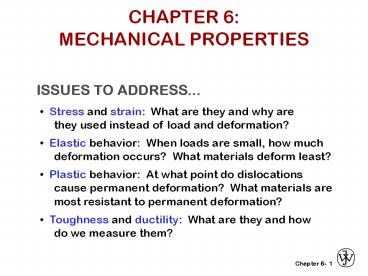CHAPTER 6: MECHANICAL PROPERTIES - PowerPoint PPT Presentation
1 / 25
Title:
CHAPTER 6: MECHANICAL PROPERTIES
Description:
MECHANICAL PROPERTIES ISSUES TO ADDRESS... Stress and strain: What are they and why are they used instead of load and deformation? Elastic behavior: When ... – PowerPoint PPT presentation
Number of Views:44
Avg rating:3.0/5.0
Title: CHAPTER 6: MECHANICAL PROPERTIES
1
CHAPTER 6 MECHANICAL PROPERTIES
ISSUES TO ADDRESS...
Stress and strain What are they and why are
they used instead of load and deformation?
Elastic behavior When loads are small, how
much deformation occurs? What materials
deform least?
Plastic behavior At what point do
dislocations cause permanent deformation?
What materials are most resistant to
permanent deformation?
Toughness and ductility What are they and
how do we measure them?
1
2
ELASTIC DEFORMATION
1. Initial
2. Small load
3. Unload
Elastic means reversible!
2
3
PLASTIC DEFORMATION (METALS)
1. Initial
2. Small load
3. Unload
Plastic means permanent!
3
4
ENGINEERING STRESS
Tensile stress, s
Shear stress, t
Stress has units N/m2 or lb/in2
4
5
COMMON STATES OF STRESS
Simple tension cable
Ski lift (photo courtesy P.M. Anderson)
Simple shear drive shaft
Note t M/AcR here.
5
6
OTHER COMMON STRESS STATES (1)
Simple compression
(photo courtesy P.M. Anderson)
Note compressive structure member (s lt 0 here).
(photo courtesy P.M. Anderson)
6
7
OTHER COMMON STRESS STATES (2)
Bi-axial tension
Hydrostatic compression
Pressurized tank
(photo courtesy P.M. Anderson)
(photo courtesy P.M. Anderson)
s lt 0
h
7
8
ENGINEERING STRAIN
Tensile strain
Lateral strain
Shear strain
Strain is always dimensionless.
8
9
STRESS-STRAIN TESTING
Typical tensile specimen
Typical tensile test machine
Adapted from Fig. 6.2, Callister 6e.
Other types of tests --compression
brittle materials (e.g., concrete)
--torsion cylindrical tubes, shafts.
Adapted from Fig. 6.3, Callister 6e. (Fig. 6.3
is taken from H.W. Hayden, W.G. Moffatt, and J.
Wulff, The Structure and Properties of Materials,
Vol. III, Mechanical Behavior, p. 2, John Wiley
and Sons, New York, 1965.)
9
10
LINEAR ELASTIC PROPERTIES
Modulus of Elasticity, E (also known as
Young's modulus)
Hooke's Law
s E e
Poisson's ratio, n metals n 0.33
ceramics 0.25 polymers 0.40
Units E GPa or psi n dimensionless
10
11
OTHER ELASTIC PROPERTIES
Elastic Shear modulus, G
simple torsion test
t G g
Elastic Bulk modulus, K
pressure test Init. vol Vo. Vol chg. DV
Special relations for isotropic materials
11
12
YOUNGS MODULI COMPARISON
Graphite Ceramics Semicond
Metals Alloys
Composites /fibers
Polymers
E(GPa)
Based on data in Table B2, Callister
6e. Composite data based on reinforced epoxy with
60 vol of aligned carbon (CFRE), aramid (AFRE),
or glass (GFRE) fibers.
12
13
USEFUL LINEAR ELASTIC RELATIONS
Simple tension
Simple torsion
Material, geometric, and loading parameters
all contribute to deflection. Larger
elastic moduli minimize elastic deflection.
13
14
PLASTIC (PERMANENT) DEFORMATION
(at lower temperatures, T lt Tmelt/3)
Simple tension test
14
15
YIELD STRENGTH, sy
Stress at which noticeable plastic deformation
has occurred.
when ep 0.002
15
16
YIELD STRENGTH COMPARISON
Room T values
Based on data in Table B4, Callister 6e. a
annealed hr hot rolled ag aged cd cold
drawn cw cold worked qt quenched tempered
16
17
TENSILE STRENGTH, TS
Maximum possible engineering stress in tension.
Adapted from Fig. 6.11, Callister 6e.
Metals occurs when noticeable necking
starts. Ceramics occurs when crack
propagation starts. Polymers occurs when
polymer backbones are aligned and about to
break.
17
18
TENSILE STRENGTH COMPARISON
Room T values
Based on data in Table B4, Callister 6e. a
annealed hr hot rolled ag aged cd cold
drawn cw cold worked qt quenched
tempered AFRE, GFRE, CFRE aramid, glass,
carbon fiber-reinforced epoxy composites, with 60
vol fibers.
18
19
DUCTILITY, EL
Plastic tensile strain at failure
Adapted from Fig. 6.13, Callister 6e.
Another ductility measure
Note AR and EL are often comparable.
--Reason crystal slip does not change material
volume. --AR gt EL possible if internal
voids form in neck.
19
20
TOUGHNESS
Energy to break a unit volume of material
Approximate by the area under the stress-strain
curve.
20
21
HARDNESS
Resistance to permanently indenting the
surface. Large hardness means
--resistance to plastic deformation or cracking
in compression. --better wear
properties.
Adapted from Fig. 6.18, Callister 6e. (Fig. 6.18
is adapted from G.F. Kinney, Engineering
Properties and Applications of Plastics, p. 202,
John Wiley and Sons, 1957.)
21
22
HARDENING
An increase in sy due to plastic deformation.
Curve fit to the stress-strain response
22
23
DESIGN OR SAFETY FACTORS
Design uncertainties mean we do not push the
limit. Factor of safety, N
Often N is between 1.2 and 4
Ex Calculate a diameter, d, to ensure that
yield does not occur in the 1045 carbon
steel rod below. Use a factor of safety of
5.
5
23
24
SUMMARY
Stress and strain These are
size-independent measures of load and
displacement, respectively.
Elastic behavior This reversible behavior
often shows a linear relation between
stress and strain. To minimize deformation,
select a material with a large elastic
modulus (E or G).
Plastic behavior This permanent deformation
behavior occurs when the tensile (or
compressive) uniaxial stress reaches sy.
Toughness The energy needed to break a unit
volume of material.
Ductility The plastic strain at failure.
Note For materials selection cases related to
mechanical behavior, see slides 22-4 to 22-10.
24
25
ANNOUNCEMENTS
Reading
Core Problems
Self-help Problems
0































